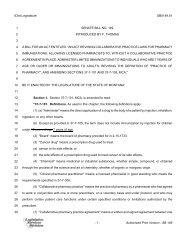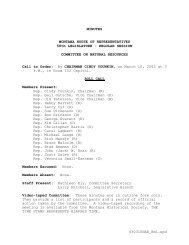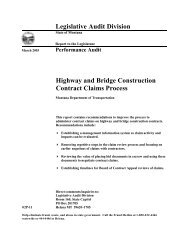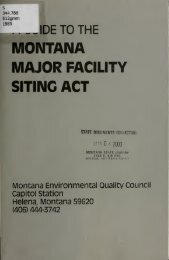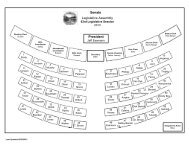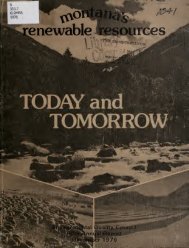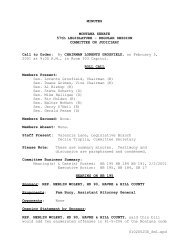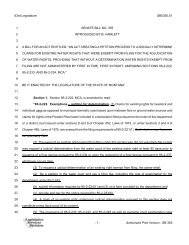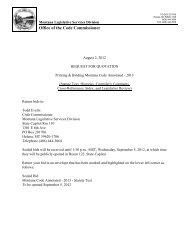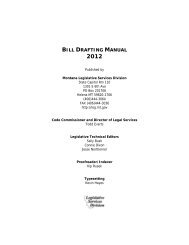Public Comment. Volume III - Montana Legislature
Public Comment. Volume III - Montana Legislature
Public Comment. Volume III - Montana Legislature
Create successful ePaper yourself
Turn your PDF publications into a flip-book with our unique Google optimized e-Paper software.
LC 7034: This proposal apparently requires a condemnor to show by a<br />
preponderance of the evidence that the project is in the public interest.<br />
Presently under <strong>Montana</strong> law the allowed uses for condemnation are specified<br />
in statute. If condemnation is sought for one of the permitted uses then it is<br />
allowed assuming the condemnor can satisfy the other requirements of the<br />
statute. I believe the existing procedure is satisfactory and in fact superior to<br />
the suggested change.<br />
A significant advantage of the existing procedure is certainty. The statute<br />
spells out exactly what public uses qualify under the Eminent Domain statutes.<br />
LC 7034 would eliminate that certainty, and leave the determination of what<br />
projects qualify for eminent domain to a judge or jury made on a case by case<br />
or ad hoc basis. Allowing a jury or a judge to determine whether a project is in<br />
the public interest will result in inconsistencies in application of the law. For<br />
example, a jury in one location may think a mine, a road, or a highway is in the<br />
public interest whereas in another location where 'the project was more<br />
controversial, a different jury presented with similar facts may disagree.<br />
Compounding the uncertainty is the fact that public interest is not defined.<br />
While it may be possible to craft a definition of public interest, it would have to<br />
be so broad and therefore vague it would be virtually meaningless insofar as<br />
providing any reliable standards.<br />
The suggested change also fails to address which court would have the<br />
authority to make the determination that a project is in .the public interest. Many<br />
projects such as highways, power lines or railroads stretch over several judicial<br />
districts. Obviously a condemnor should not be required to obtain a<br />
determination that the project is in the public need from each of the judges in<br />
the judicial districts affected by the project, yet I see no basis to arbitrarily<br />
designate a a particular judge to make that determination. There is no such<br />
problem with respect to determination of just compensation, because each<br />
parcel of property has its own ur~ique characteristics which affect value, and<br />
those characteristics can be recognized in determining just compensation.<br />
Finally, under the suggested change, the decision of whether the project is in<br />
the public interest would presumably be subject to review by an appellate court<br />
thereby delaying planning and increasing the cost of the project. (Holland &<br />
Hart)<br />
We agree with the finding and draft recommendation as outlined in the report.<br />
(W ETA)<br />
<strong>Montana</strong> Petroleum Association believes the Subcommittee's "Findings" and<br />
"Draft Recommendations" fairly represent and balance the evidence presented<br />
to the Subcommittee. (MPA)<br />
-50- <strong>Volume</strong> Ill: <strong>Public</strong> <strong>Comment</strong>



